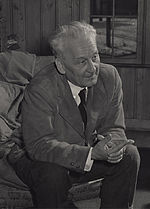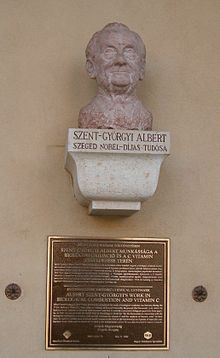- Albert Szent-Györgyi
-
Albert Szent-Györgyi 
Albert Szent-Györgyi en 1948Nombre Albert Szent-Györgyi de Nagyrápolt Nacimiento 16 de septiembre de 1893
 Budapest, Imperio Austrohúngaro
Budapest, Imperio AustrohúngaroFallecimiento 22 de octubre de 1986 (93 años)
 Woods Hole, Estados Unidos
Woods Hole, Estados UnidosNacionalidad húngaro Alma mater Semmelweis University,
Universidad de CambridgeOcupación Fisiólogo, Bioquímico Conocido por Vitamina C, descubrimiento de los componentes y reacciones del ciclo del ácido cítrico Cónyuge June Susan Wichterman (1965–1968)
Marcia Houston (1975–1986)Padres Jozefin Lenhossék
Miklós Szent-GyörgyiPremios Premio Nobel en 1937.
Premio Lasker en 1954.
Miembro de la Academia Nacional de Ciencias de Estados Unidos en 1956.Sitio web
www.nobelprize.orgAlbert Szent-Györgyi de Nagyrápolt (Budapest, 16 de septiembre de 1893 – Woods Hole, Massachusetts, 22 de octubre de 1986) fue un fisiólogo húngaro, galardonado con el Premio Nobel de Fisiología o Medicina en 1937.
Su padre, Miklós Szent-Györgyi era terrateniente. Su madre, Jozefin, era hija de József Lenhossék y hermana de Mihály Lenhossék, ambos profesores de anatomía en la Universidad de Budapest.
Los trabajos de Szent-Györgyi estuvieron relacionados con la química de la respiración. En la Universidad de Szeged, empleó pimentón como fuente de vitamina C (el L-enantiómero del ácido ascórbico) y se dio cuenta de su actividad contra el escorbuto. Estudió la oxidación celular y descubrió la vitamina C en 1927.
En 1937 recibió el Premio Nobel de Fisiología y Medicina por sus descubrimientos en relación con los procesos de combustión biológica, en especial los referidos a la vitamina C y la catálisis del ácido fumárico.
Contenido
Biografía
Nació el 16 de septiembre de 1893 en la ciudad de Budapest, en aquellos momentos ciudad situada en el Imperio Austrohúngaro y hoy en día capital de Hungría. Inició sus estudios de medicina en la Universidad de Budapest, que combinó con sus propias investigaciones en el laboratorio químico de su tío. Debido a la Primera Guerra Mundial, donde sirvió como médico, tuvo que interrumpir sus estudios. Durante la Gran Guerra se disparó en un pie para abandonar el frente, hecho que le permitió finalizar sus estudios el año 1917.
Inició su investigación científica en la ciudad de Pozsony, hoy en día Bratislava. Cuando la ciudad se convirtió en parte de Checoslovaquia en enero de 1919, abandonó la villa junto a la mayor parte de población de origen húngaro. Posteriormente desarrolló su investigación en la Universidad de Groningen, centrándose en la química de la respiración celular. Gracias a estos trabajos y a una beca de la Fundación Rockefeller viajó a la Universidad de Cambridge, donde se doctoró en 1927 gracias a su trabajo en el aislamiento del "ácido hexurónico", hoy en día denominado Vitamina C.
Posteriormente, en la Universidad de Szeged utilizó Capsicum annuum como fuente de vitamina C (el L-enantiómero del ácido ascórbico) y se dio cuenta de su actividad anti-escorbútica. El año 1937 fue galardonado con el premio Nobel de Medicina y Fisiología «por su descubrimiento relacionado con los procesos de combustión biológica, con especial referencia a la vitamina C y a la catálisis de los ácidos fumáricos».[1]
Durante la Segunda Guerra Mundial participó activamente en la Resistencia húngara. Aunque Hungría se alió con las potencias del Eje, el primer ministro húngaro Miklós Kállay envió a Szent-Györgyi a la ciudad de Estambul el año 1944 para realizar negociaciones secretas con los Aliados.
Adolf Hitler dictó una orden de detención de Szent-Györgyi, pero este se escapó de la Gestapo y permaneció escondido dos años. Después de la guerra recuperó su puesto e incluso se especuló con la posibilidad que los soviéticos lo nombraran primer ministro, por lo que se afilió al Partido Comunista de Hungría y fue elegido miembro del Parlamento a la vez que creó el laboratorio de Bioquímica de la Universidad de Budapest y restableció la Academia de Ciencias de Hungría. Descontento con el gobierno, emigró a los Estados Unidos el año 1947, siendo nombrado ciudadano el año 1955.
Durante su estancia en norteamérica, creó su propio laboratorio en la ciudad de Woods Hole, situada en el estado de Massachusetts e inició sus investigaciones sobre el cáncer, desarrollando teorías sobre física cuántica aplicadas a la bioquímica de esta enfermedad. Durante la década de 1970 su búsqueda lo condujo a deducir que los radicales libres eran una causa potencial del cáncer. Murió el 22 de octubre de 1986.
Referencias
- ↑ «The Nobel Prize in Physiology or Medicine 1937». Nobel Foundation. Consultado el 15 de noviembre de 2010.
Bibliografía
- US National Library of Medicine. The Albert Szent-Györgyi Papers.NIH Profiles in Science
- Ralph Moss (1988). Free Radical Albert Szent-Györgyi and the Battle over Vitamin C. Paragon House Publishers. ISBN 0-913729-78-7.
- Szolcsányi, János (October 2007). «[Memories of Albert Szent-Györgyi in 1943 about the beginning of his research and about his mentor, Géza Mansfeld]». Orvosi hetilap 148 (42): pp. 2007–11. doi:. PMID 17932008.
- Juhász-Nagy, Sándor (March 2002). «[Albert Szent-Györgyi—biography of a free genius]». Orvosi hetilap 143 (12): pp. 611–4. PMID 11963399.
- Vértes, L (December 2000). «[László Németh and Albert Szent-Györgyi. Honoring anniversaries]». Orvosi hetilap 141 (52): pp. 2831–3. PMID 11202120.
- Manchester, K L (January 1998). «Albert Szent-Györgyi and the unravelling of biological oxidation». Trends Biochem. Sci. 23 (1): pp. 37–40. doi:. PMID 9478135.
- Gábor, M (January 1996). «[Albert Szent-Györgyi and flavonoid research]». Orvosi hetilap 137 (2): pp. 83–4. PMID 8721874.
- Nagy, I Z (1995). «Semiconduction of proteins as an attribute of the living state: the ideas of Albert Szent-Györgyi revisited in light of the recent knowledge regarding oxygen free radicals». Exp. Gerontol. 30 (3–4): pp. 327–35. doi:. PMID 7556511.
- Zallár, A; Szabó T (April 1989). «Habent sua fata libelli: the adventurous story of Albert Szent-Györgyi's book entitled Studies on Muscle (1945)». Acta Physiol. Scand. 135 (4): pp. 423–4. doi:. PMID 2660487.
- Szilárd, J (May 1988). «[The Nobel prize. (Pro memoria Albert Szent-Györgyi). The University of Szeged Medical School named after Albert Szent-Györgyi]». Orvosi hetilap 129 (18): pp. 949–50. PMID 3290769.
- Szabó, T; Zallár A, Zallár I (1988). «Albert Szent-Györgyi in Szeged». Geographia medica 18: pp. 153–6. PMID 3049243.
- Banga, I (January 1987). «[In memory of Albert Szent-Györgyi]». Orvosi hetilap 128 (2): pp. 97–8. PMID 3547244.
- Cohen, S S (1987). «Thoughts on the later career of Albert Szent-Gyorgyi». Acta Biochim. Biophys. Hung. 22 (2–3): pp. 141–8. PMID 3118622.
- Straub, F B (1987). «The charismatic teacher at Szeged: Albert Szent-Györgyi». Acta Biochim. Biophys. Hung. 22 (2–3): pp. 135–9. PMID 3118621.
- «[Salute to the 90-year old Albert Szent-Györgyi]». Orvosi hetilap 124 (40): pp. 2435–6. October 1983. PMID 6369221.
- Bendiner, E (May 1982). «Albert Szent-Györgyi: the art in being wrong». Hospital practice (Hospital ed.) 17 (5): pp. 179–84, 185–6, 192. PMID 7044943.
- Szállási, A (February 1980). «[Albert Szent-Györgyi in the journal Nyugat]». Orvosi hetilap 121 (8). PMID 6992048.
- Holden, C (February 1979). «Albert-Szent-Györgyi, electrons, and cancer». Science 203 (4380): pp. 522–4. doi:. PMID 366748.
- Süle, T (December 1977). «[Albert Szent-Györgyi in Hungarian numismatics]». Orvosi hetilap 118 (52): pp. 3170–1. PMID 341025.
- Szállási, A (November 1977). «[Albert Szent-Györgyi was awarded the Nobel Prize 40 years ago]». Orvosi hetilap 118 (46): pp. 2782–3. PMID 335333.
- Kardos, I (1975). «A talk with Albert Szent-Györgyi». The New Hungarian quarterly 16 (57): pp. 136–50. PMID 11635455.
- Szállási, A (December 1974). «[2 interesting early articles by Albert Szent-Györgyi]». Orvosi hetilap 115 (52): pp. 3118–9. PMID 4612454.
- Kenéz, J (December 1973). «[Eventful life of a scientist. 80th birthday of Nobel prize winner Albert Szent-Györgyi]». Münchener medizinische Wochenschrift (1950) 115 (51): pp. 2324–6. PMID 4589872.
- Miura, Y (December 1969). «[Doctor Albert von Szent-Gyoergyi]». Nippon Ishikai zasshi. Journal of the Japan Medical Association 62 (11): pp. 1164–8. PMID 4903813.
- Kenéz, J (December 1968). «[Albert Szent-Györgyi is 75 years old]». Orvosi hetilap 109 (50): pp. 2777–81. PMID 4887815.
- Sulek, K (May 1968). «[Nobel prize for Albert Szant-Györgyi in 1937 for studies on the metabolic processes, particularly of vitamin C and catalysis of fumaric acid]». Wiad. Lek. 21 (10). PMID 4875831.
Enlaces externos
 Wikimedia Commons alberga contenido multimedia sobre Albert Szent-Györgyi. Commons
Wikimedia Commons alberga contenido multimedia sobre Albert Szent-Györgyi. Commons- Biography of Albert Szent-Györgyi, de Nobel Lectures, Physiology or Medicine 1922–1941
- Entrevista en la BBC, 1965
- Colección de materiales digitalizados sobre el trabajo por la paz de Szent-Györgyi y Linus Pauling.
- The Albert Szent-Gyorgyi Papers
Predecesor:
Henry Hallett Dale
Otto LoewiPremio Nobel de Fisiología o Medicina
1937Sucesor:
Corneille HeymansCategorías:- Nacidos en 1893
- Fallecidos en 1986
- Premio Nobel de Fisiología o Medicina
- Fisiólogos de Hungría
- Premio Lasker
- Aquincenses
- Miembros de la Academia Pontificia de las Ciencias
- Premios Nobel de Hungría
- Nacionalizados de Estados Unidos
- Húngaro-estadounidenses
- Comunistas de Hungría
Wikimedia foundation. 2010.

